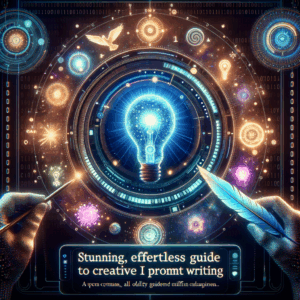
Prompt Refinement: Stunning Secrets For Best AI Prompts
Prompt refinement helps you get more from AI. It transforms vague instructions into powerful, repeatable prompts. As a result, you receive clearer, relevant, and usable AI outputs.
In this article, I share practical secrets and methods. You will learn techniques, templates, and tests. These ideas suit marketers, developers, writers, and curious users alike.
Clear prompts save time and reduce frustration. When you refine prompts, the AI returns answers that match your goals. Consequently, you spend less time editing or re-running tasks.
Furthermore, prompt quality affects output bias and reliability. A well-crafted prompt reduces hallucinations and off-topic responses. Thus, prompt refinement improves both speed and accuracy.
First, define your goal in one sentence. This creates a north star for your prompt. Then, state the format and length you expect.
Second, provide context and constraints. For example, include the audience, tone, and output structure. Finally, test and iterate. Prompt refinement is a cycle, not a one-off job.
Be precise and concrete. Replace vague words like “good” with specific metrics or examples. For instance, “one-paragraph summary under 100 words” beats “short summary.”
Use concrete instructions for structure and content. Ask for bullet points, headings, or a table. Also, explain required data types, such as dates, numeric ranges, or categories.
Constraints prevent rambling and irrelevant answers. You can constrain length, style, sources, or format. For example, request “3 bullets, each with an action item.”
Constraints also enforce compliance with limits like privacy rules. When you add rules, the model reduces unsafe or off-topic suggestions. Therefore, always list must-haves and must-nots.
Examples provide a strong anchor. When you include a sample output, the AI mirrors its style. For instance, show a sample headline or a desired table layout.
Provide both positive and negative examples if possible. A positive example shows success. A negative example shows what to avoid. That combination improves predictability.
Complex tasks benefit from step-by-step prompts. First, ask the model to outline a plan. Then, request each part separately. This method reduces errors and keeps the output manageable.
You can also use “progressive prompting.” Start broad, then refine. For instance, generate ideas, pick one, expand it, then polish. This approach mirrors human workflows.
Adjust the temperature parameter to tune creativity. Lower temperatures make responses more deterministic. Higher values increase diversity and unpredictability.
Also tweak top-p or other sampling controls. Use conservative settings for factual tasks. Use bolder settings for brainstorming and ideation.
System or role prompts define behavior. Start prompts with a role like “You are an expert copywriter.” This primes the model’s style and approach. Consequently, the AI aligns better with your needs.
Use system messages for safety and ethics. For instance, instruct the model to avoid medical advice or to flag uncertainty. System-level constraints persist across conversation turns.
Few-shot prompting includes a couple of examples in the prompt. It helps the model generalize from patterns. Use it when the task is specific but repeatable.
Zero-shot prompting asks the model without examples. It works for broad tasks or when you lack sample outputs. Yet, zero-shot requires clearer instructions and constraints.
Below is a quick comparison table to illustrate prompt quality.
| Element | Weak Prompt | Strong Prompt |
|—|—:|—|
| Goal | “Write about AI.” | “Write a 200-word intro for non-technical readers about AI safety.” |
| Tone | “Make it fun.” | “Use a friendly, conversational tone for ages 25-45.” |
| Structure | “Explain benefits.” | “Give 3 benefits in bullets, with one-line examples each.” |
| Constraints | “Be short.” | “Max 150 words; no technical jargon; cite 1 source.” |
As you can see, the strong prompt provides a clearer path. It reduces ambiguity and speeds up useful output.
Test prompts like you test code. Run several variations and compare results. Keep a log of prompt versions and outcomes.
Use metrics to compare performance. Track relevance, factuality, and time saved. Also gather human feedback from reviewers or clients.
Templates speed up prompt creation and ensure consistency. Create templates for tasks like email writing, summarization, or code generation. Store them in a prompt library.
Below are common templates you can adapt quickly:
– Summarization: “Summarize the following text in X words with Y bullets.”
– Content brief: “Generate an outline with headings and SEO keywords for topic Z.”
– Email: “Write a professional follow-up email given context A and tone B.”
Templates let you reuse refined prompts. Consequently, you increase quality across teams.
Avoid being vague or overly complex. Vague prompts lead to unpredictable answers. Overly complex prompts confuse the model and the reader.
Also avoid mixing multiple goals in one prompt. If you need two outputs, split the task into separate prompts. Finally, don’t forget to specify the output format clearly.
Use meta-prompts to instruct the model about how to answer. For example, ask the model to critique its own output. Request “Explain why this answer may be wrong.”
Self-reflection prompts lead to higher accuracy. Ask the model to list assumptions and potential errors. Then, correct or refine the prompt based on these notes.
Prompt chaining passes outputs from one prompt to another. For instance, generate an outline, then pass that to a writer prompt. This modular approach allows complex production systems.
In multi-agent workflows, different prompts handle distinct roles. One agent brainstorms ideas, another edits, and a third checks facts. This structure mimics editorial teams.
Prompt refinement includes safety checks. Test prompts on diverse inputs to reveal biases. Also include explicit safeguards against discriminatory or harmful outputs.
Use guardrails like blacklists or safety instructions. If your application serves sensitive audiences, involve domain experts. This reduces legal and reputational risks.
Several tools help you iterate faster. Prompt managers let you store versions, run A/B tests, and collect metrics. Prompt playgrounds show live parameter changes.
Popular tools and features:
– Version control for prompts
– Auto-generated prompt suggestions
– Built-in A/B testing
– Team collaboration and annotation
Choose tools that integrate with your workflow and data privacy needs.
Here’s a simple workflow you can adopt:
1. Define the goal and target audience.
2. Create a base prompt with constraints.
3. Run the prompt and collect outputs.
4. Evaluate and refine using metrics and examples.
5. Finalize the prompt and save it as a template.
For larger projects, expand steps. Add role-based prompts, fact-checking passes, and editorial review cycles. Repeat the process until results meet your standards.
Marketing teams improve conversion rates with targeted prompts. They refined email prompts to ask for specific CTAs. As a result, open and click-through rates climbed.
Product teams used prompt chains to generate test cases. They split the task into scenario generation and assertion writing. Consequently, testing coverage increased and bug discovery sped up.
Track both qualitative and quantitative metrics. Use accuracy, relevance, and editing time as your primary KPIs. Also measure user satisfaction and conversion metrics.
Consider A/B testing different prompt versions. Measure downstream effects like time saved and content performance. Use these insights to prioritize further prompt refinement.
Treat prompts like code or content. Use version control and changelogs. This practice helps teams reproduce results and audit changes.
Create a naming convention for clarity. Include metadata like purpose, author, and last-tested date. This habit prevents confusion as prompt libraries grow.
Even the best prompts need human review. Use editors to check tone, facts, and legal compliance. The human-in-the-loop approach balances speed and quality.
Set clear review guidelines. Define when content requires full human approval. Automation can handle drafts and routine edits, while humans make final calls.
Prompt refinement must respect privacy and fairness. Avoid asking models to hallucinate personal data. Also, instruct models to cite sources when possible.
Include legal and ethical constraints in system prompts. For example, require the model to avoid giving medical advice. Engage legal counsel for regulated fields.
Tailor prompts to fit each use case. For technical documentation, emphasize accuracy and examples. For marketing, stress tone, conversions, and calls to action.
Adjust parameters depending on the task. Editorial tasks may use lower temperature and higher top-p controls. Brainstorming tasks can use creative settings for variety.
Use this checklist for everyday refinement:
– State the objective in one line.
– Specify audience and tone.
– Set format, length, and constraints.
– Provide examples and counterexamples.
– Add system or role instructions.
– Run tests and collect metrics.
– Store the best version in a library.
This list helps you standardize the process across projects.
Here are repeatable patterns you can adapt:
– Instruction + Format: “Explain X. Use headings and 5 bullets.”
– Role-based + Task: “You are a product manager. Draft a roadmap for Y.”
– Example-driven: “Rewrite this text in the style of Z. Here is a sample.”
Save these patterns in templates to speed future work.
Below are sample prompts you can copy and adapt.
Example 1 — Blog intro:
“You are an experienced content writer. Write a 150-word introduction for non-technical readers about prompt refinement. Use friendly tone and one example.”
Example 2 — Feature list:
“List 5 benefits of prompt refinement for product teams. Use bullets and one-sentence explanations.”
Example 3 — Email:
“Write a professional follow-up email. Keep it under 120 words. Mention last meeting and propose two time slots.”
Modify these examples to match your needs.
Periodically review your prompt library. Remove outdated constraints and refine new ones. Keep logs of performance changes after updates.
Train team members on prompt hygiene. Encourage sharing successful prompts and failures. This culture accelerates learning and quality improvements.
Start with small, repeatable tasks. Refine prompts for those tasks first. Then scale to complex workflows.
Use human feedback and simple metrics to prioritize work. Also, avoid over-optimizing early. Often, small, clear changes yield big improvements.
Prompt refinement unlocks better AI collaboration. You gain clearer outputs, faster cycles, and less waste. By applying principles like clarity, constraints, and iterative testing, you achieve more predictable results.
Create templates, measure performance, and involve humans where needed. With consistent practice, prompt refinement becomes a competitive advantage.
1. What is the fastest way to improve a weak prompt?
Start by clarifying the goal and adding a concrete output format. Then, add one example and rerun the prompt.
2. How many iterations does prompt refinement usually require?
It varies. Simple tasks often need two to five iterations. Complex workflows may require many more iterations.
3. Can I automate prompt refinement?
You can automate parts, like parameter sweeps and A/B testing. However, human review remains essential for nuance and ethics.
4. Does prompt refinement reduce hallucinations?
Yes, when you add constraints, cite requests, and ask for source lists. Those steps lower hallucination risk, but they don’t eliminate it.
5. Is prompt refinement the same across models?
Principles stay similar, but optimal settings may differ. Always test on your chosen model.
6. How do I measure prompt quality objectively?
Use metrics like relevance, factuality, and editing time. Pair quantitative metrics with human reviews for best results.
7. Should I store prompts in plain text?
Store prompts with metadata and version history. Plain text is fine, but use a system that supports search and access controls.
8. How do I handle sensitive or regulated content?
Add explicit safety and compliance constraints. Consult legal and domain experts and use human review.
9. Can non-technical users practice prompt refinement?
Absolutely. Start with templates and small tasks. Provide simple checklists and tools that remove technical friction.
10. When should I use few-shot instead of zero-shot?
Use few-shot when you can provide good examples. Zero-shot works for broader tasks or when examples are unavailable.
– OpenAI: Best practices for prompt design — https://platform.openai.com/docs/guides/best-practices
– Google Research: Prompting for Large Language Models — https://ai.google/research/prompting
– Microsoft: Responsible AI principles and practices — https://learn.microsoft.com/en-us/azure/ai-service/responsible-ai
– Anthropic: Helpful prompting techniques — https://www.anthropic.com/index/ai-safety-techniques
– Papers with Code: Prompt engineering resources — https://paperswithcode.com/method/prompt-engineering

